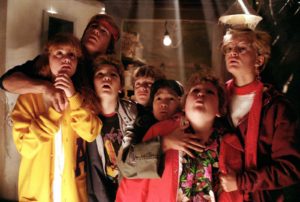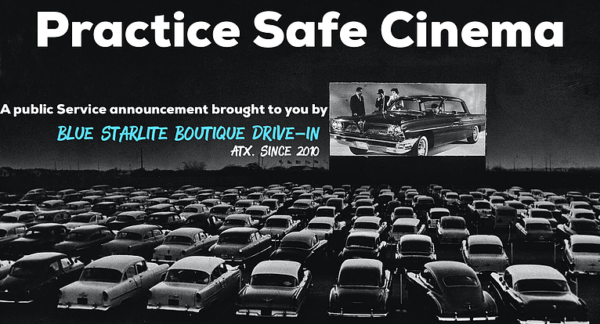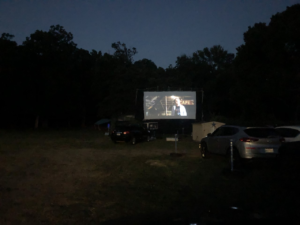by Eric Clow
With COVID-19 surging in several states, a return to “normal” slips further away. Though physically distancing ourselves seems to be the key to our survival in this pandemic, the social distance that creates might also have harmful emotional and mental side effects. We are communal creatures, after all.
Various solutions have risen to the challenge, perhaps none as ubiquitous as Zoom, which is now something of an umbrella term for video chat apps in general. Many modes of connection depend on computer technology and the Internet while others turn to the past for inspiration–as is the case with drive-in movie theaters, a retro novelty that might now be our safest cinema viewing option outside the home. Since a number of articles have heralded the return of the drive-in movie, we at Art Spark naturally grew curious. Just how accessible–and safe–is the drive-in?
 Being a wheelchair user and a cinephile, I gladly accepted the task of heading to a local drive-in to scope out the accessibility and share suggestions of what our readers should keep in mind for an optimal drive-in experience. For my drive-in adventure, I selected the Blue Starlite Mini Urban Drive-In because it was nearby (located just outside the Mueller shopping district, between Manor and MLK on EM Franklin Ave) and I had never been to a mini drive-in, of which the Blue Starlite is apparently the first of its kind. Plus, it was showing The Goonies, a film I had surprisingly not yet seen!
Being a wheelchair user and a cinephile, I gladly accepted the task of heading to a local drive-in to scope out the accessibility and share suggestions of what our readers should keep in mind for an optimal drive-in experience. For my drive-in adventure, I selected the Blue Starlite Mini Urban Drive-In because it was nearby (located just outside the Mueller shopping district, between Manor and MLK on EM Franklin Ave) and I had never been to a mini drive-in, of which the Blue Starlite is apparently the first of its kind. Plus, it was showing The Goonies, a film I had surprisingly not yet seen!
“Practice Safe Cinema”
Before scurrying out for a fun evening at the drive-in, a venue that on the surface feels perfectly safe, it is important to remember the pandemic is still a very real threat, even for those in seemingly good health. Although you can theoretically stay in your own vehicle with the windows rolled up, you are still putting yourself in an environment where people are congregating–an inherent risk. Many drive-in theaters currently operating have extensive social distancing rules posted on their websites. Familiarize yourself with these protocols so you can act accordingly and also to help you decide which specific theater best matches your own expectations of safety.

If a theater allows something, that doesn’t necessarily mean it is unequivocally safe. For example, though the Blue Starlite required our car windows to be 75% up when not wearing masks, we felt more comfortable keeping them closed. And while we could have had concessions brought to our car, or accessed the public restrooms, we opted to bring our own snacks and use the bathroom at home beforehand to minimize physical contact with others. Thankfully, the staff at Blue Starlite now permit patrons to run their AC and bring in outside food and drinks in consideration of social distance guidelines.
Wheelchair Access

Since I did not leave my van to use the restroom or otherwise explore the grounds, which were quite expansive (the Starlite boasts five screens!), my thoughts on wheelchair accessibility are limited. What I can say is, if you use a big power wheelchair that sits high off the ground like mine… park in the back! Or prepare to crane your neck to see the screen. When we arrived, the staff directed us to the very front, after which we had to back up probably 100 or so feet before I could comfortably enjoy the movie. Luckily, they were accommodating. By our third request to back up farther, they simply told us, “go as far as you need.”
A few other things to keep in mind:
- If you need help eating during the movie, pick something that isn’t overly messy or difficult for your companion to feed you. Save the nachos for a night in!
- Position your chair in such a way that you can use seat adjustments like tilt, recline, and foot elevation to lessen discomfort.
- Or, if you can ambulate, transfer to one of the car’s seats.
- Bring a pillow.
Captions and Audio Description
Of course, accessibility is not merely a consideration of people who use wheelchairs. I inquired with both the Blue Starlite and Doc’s Drive-In if they offer captioned and/or audio described screenings. The owner of the Starlite cited the age of their system–and the technology of drive-ins generally–for the inability to broadcast multiple audio channels simultaneously. Captions would similarly need to be embedded in the movie itself–and thus visible to the entire audience. Because of these limitations, they currently provide these accommodations through setting up specific screenings on request. Doc’s can also project captions by request.
If you require other accommodations, I would definitely ask! The staff of both drive-in theaters with whom I communicated sounded open and flexible. Especially in this strained economy, many businesses are happy to have customers and want to give them all a good experience.
Are You Ready?
This unprecedented crisis has been difficult for everyone, and each person copes with challenges differently. Some may feel ready to venture forth into a potentially risky unknown while others simply aren’t there yet. As Blue Starlite owner Josh Frank puts it, “Don’t go out until you are ready — even to our place… Everyone has their own emotional and physical feeling of safety at this time and no one’s feelings are wrong.”
Check in with yourself emotionally and then decide. But when you are ready, the drive-in is a safer way to a fun night out!
As every drive-in is a little different, we would also love to hear about your own experiences. How accessible was your night? Did you receive the accommodations you needed? Tell us in the comments!
